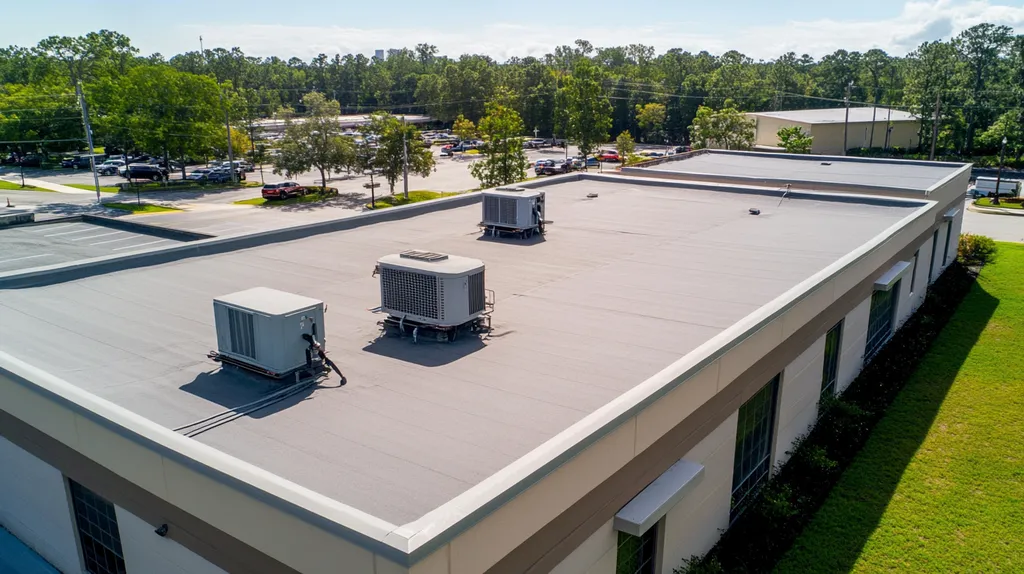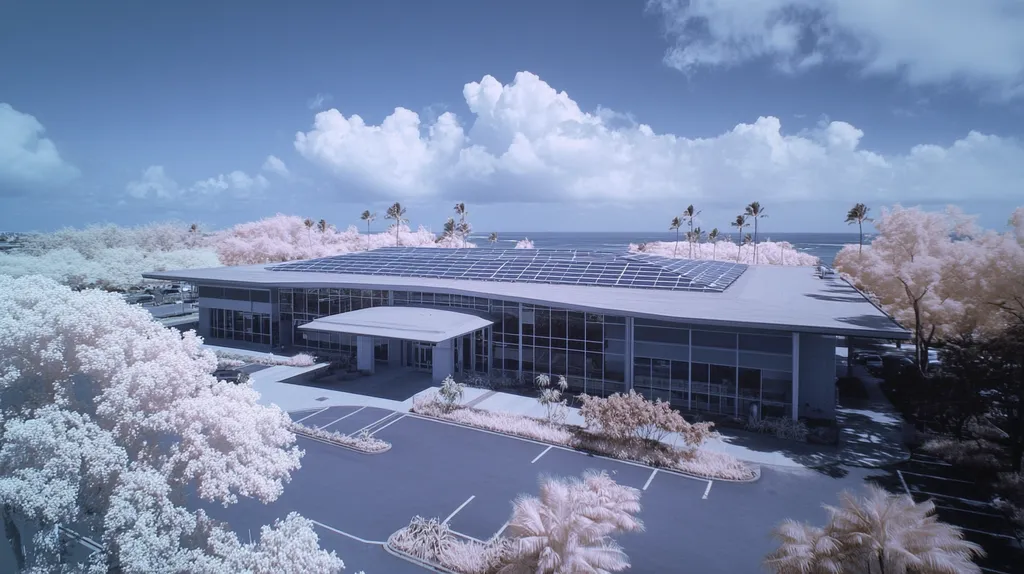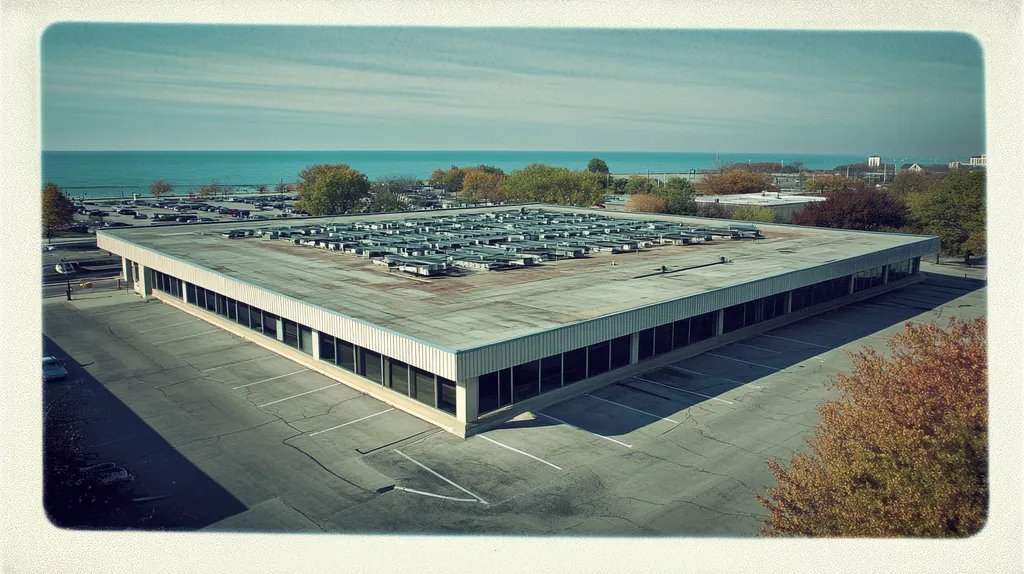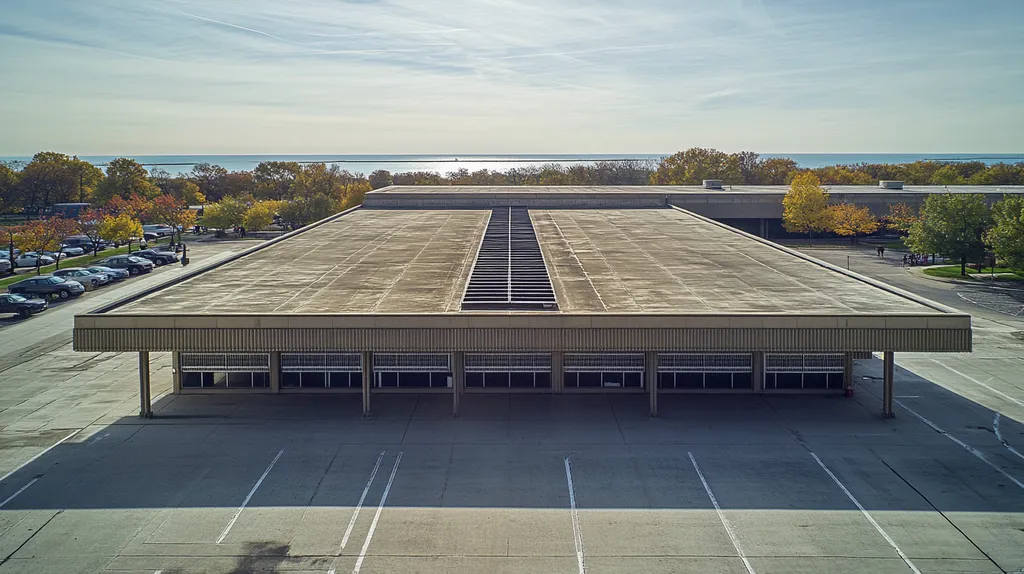Selecting the wrong thickness for an industrial roof membrane can trigger catastrophic failures, with industry data showing that 40% of commercial roof replacements stem from inadequate membrane specifications.
For facility managers, membrane thickness decisions directly impact building protection, energy efficiency, and long-term maintenance costs – often representing investments of $500,000 or more for typical industrial facilities.
This comprehensive guide examines the critical factors in determining optimal roof membrane thickness, from performance requirements and financial considerations to compliance standards and risk management protocols.
SECTION 1: PERFORMANCE FACTORS
Choosing the appropriate thickness for industrial roof membranes is a vital decision that can directly affect the roof’s performance and lifespan. Interestingly, nearly 30% of all commercial roofing failures result from insufficient membrane thickness, highlighting the importance of this factor for facility managers. Selecting the right thickness not only boosts durability but also strengthens weather and puncture resistance while ensuring complete surface coverage. Grasping these performance factors is essential for making informed roofing choices.
Weather Resistance and Durability
Weather resistance should be a top priority for any industrial roofing system. Facilities located in areas prone to harsh weather, such as heavy rain or blistering sun, benefit greatly from thicker membranes that provide superior protection. A thicker membrane can handle thermal expansion and contraction better than thinner versions, helping to prevent cracks and leaks.
In addition to better overall protection, greater thickness typically means enhanced UV resistance, which slows down wear over time. In commercial settings, insufficient weather resistance can result in significant issues like leaks, water damage, and costly downtime. Thicker membranes can markedly improve the durability of the roof.
When determining the necessary membrane thickness, facility managers should take local climate conditions into account. For example, buildings situated in rainy regions might require membranes engineered for enhanced water resistance. By taking a proactive stance, managers can minimize wear and prolong the roof’s structural integrity.
Key Action Items
Puncture and Tear Resistance
Puncture and tear resistance is vital for industrial roofs, especially those frequently exposed to foot traffic and heavy equipment. Generally, thicker membranes show increased resistance to damage from sharp objects or heavy loads, directly affecting the roof’s lifespan.
For instance, many industry experts recommend membranes with a thickness of at least 60 mils for areas where mechanical operations occur regularly. Choosing a membrane that aligns with or exceeds this standard helps to prevent expensive repairs and extend the life of the roofing system.
Beyond that, thicker membranes offer additional cushioning against hail and debris, which can severely damage thinner materials. Prioritizing both puncture and tear resistance ultimately supports the long-term stability of the roof.
Key Action Items
Surface Evenness and Coverage
Surface evenness and coverage are often overlooked yet crucial in the roofing selection process. An uneven roof surface can lead to water pooling, accelerating deterioration and heightening the risk of leaks. Thicker membranes tend to provide better coverage and can adapt more effectively to uneven surfaces.
Moreover, a level surface supports proper drainage, preventing water build-up in specific areas. This is especially critical for industrial roofs that may feature various obstructions that impede water flow. Thicker membranes are better equipped to accommodate these irregularities, ultimately enhancing overall performance.
Additionally, improved surface coverage can reduce the number of seams and joints, which are common weak points in roofing systems. By opting for a thicker membrane, facility managers can lower the risk of seam-related leaks, contributing to a more dependable roofing solution.
Key Action Items
SECTION 2: FINANCIAL CONSIDERATIONS
Understanding the financial aspects of industrial roof membrane thickness is essential for facility managers. Studies indicate that choosing the wrong thickness can lead to inflated costs in both installation and ongoing maintenance. While investing in a thicker membrane might seem expensive upfront, the long-term savings related to fewer repairs and improved energy efficiency can be substantial. This section will provide insights into initial costs, ongoing maintenance expenses, and the overall economic advantages of selecting the right thickness for roof membranes.
Initial Installation Costs
The initial installation cost is a key consideration when evaluating different roof membrane thicknesses. Thicker membranes generally come with higher upfront costs, driven by greater material requirements and labor. For instance, a standard single-ply roofing system could be priced between $5 to $10 per square foot, whereas a thicker variant might reach up to $15 per square foot. However, this initial expense should be viewed in light of potential long-term savings.
Facility managers must also take local market conditions into account, as material costs can vary significantly. Getting quotes from multiple contractors can shed light on competitive pricing, influencing the choice of membrane thickness. Careful budgeting for these expenses ensures that financial planning is aligned with the project’s overall objectives.
Ultimately, investing wisely in thicker membranes can mitigate future costs associated with inadequate protection. This proactive approach can lead to better durability and a reduced risk of premature roof failure, providing greater value over time.
Key Action Items
Long-Term Maintenance Expenses
Long-term maintenance costs associated with roofing systems can have a significant impact on budgets. Thinner membranes often necessitate more frequent repairs due to their lower resistance to environmental wear and tear, leading to substantial cumulative costs over time. For example, maintaining a thinner membrane could average around $1,500 annually, while a thicker one might typically require only $1,000 for maintenance.
Facility managers should also assess historical weather data for their regions. Areas with extreme weather conditions tend to experience higher deterioration rates in less durable roofing materials. This decision on membrane thickness thus directly influences future maintenance costs and overall operational efficiency.
Additionally, thicker membranes often come with better warranties, which can further lessen financial burdens by reducing repair-related out-of-pocket expenses. Recognizing these long-term implications equips facility managers with the knowledge needed for more effective financial planning.
Key Action Items
Cost-Benefit Analysis of Thickness
Conducting a comprehensive cost-benefit analysis is essential for making informed decisions about roofing thickness. This analysis should incorporate both immediate costs and future projections, considering installation, maintenance, and overall roofing performance. Although thicker membranes may come with a higher initial price tag, their longevity often translates into significant savings throughout the roof’s lifecycle.
For instance, while a thinner membrane may be enticing due to its lower initial cost, the increased likelihood of repairs and a shorter lifespan can quickly offset any initial savings. A thorough cost-benefit analysis frequently shows that investing more in thicker materials can result in stronger financial management over time.
Moreover, advancements in roofing technology contribute to improved performance in thicker membranes, including enhanced energy efficiency. These advantages not only promote cost savings but can also positively affect the overall value of the building.
Ultimately, a detailed cost-benefit analysis empowers facility managers to make strategic roofing decisions that align with their financial objectives and operational needs.
Key Action Items
SECTION 3: COMPLIANCE REQUIREMENTS
Compliance with industry standards and regulations is essential for the safety and longevity of industrial roofing systems. Neglecting these requirements can lead to costly repairs, operational disruptions, and even legal ramifications. Research by the National Roofing Contractors Association reveals that nearly 25% of roofing failures stem from non-compliance, emphasizing the importance of understanding and adhering to these essential guidelines.
Industry Standards and Regulations
Familiarity with industry standards is crucial when determining the appropriate thickness for roof membranes. Organizations such as ASTM International and the Cool Roof Rating Council establish key benchmarks that ensure roofing materials can withstand diverse environmental conditions and adhere to safety protocols.
For example, the ASTM D6878 specification details the minimum thickness required for thermoplastic polyolefin (TPO) membranes. Not adhering to these specifications can not only affect warranty coverage but may also invalidate insurance claims. This serves as a reminder for facility managers to keep current with industry standards.
Additionally, both local and federal regulations may impose further requirements that must be factored in. Facility managers need to investigate the specific regulations applicable to their region to avoid compliance pitfalls. Understanding these details can save time and prevent expensive missteps in roofing projects.
Key Action Items
Building Code Compliance
Building codes represent the minimum legal standards for construction practices, which can vary significantly by location. Facility managers must reference local codes when planning roof installations to ensure compliance, safeguarding the roof against local weather extremes like heavy snowfall or strong winds.
For instance, the International Building Code provides guidelines for minimum insulation and membrane thicknesses based on different climate zones. Ignoring these guidelines can lead to legal challenges, resulting in fines and mandatory modifications. Thus, adherence to building codes is essential for maintaining property value and investment security.
Furthermore, a non-compliant roof can deter potential buyers or create future liabilities. Engaging with a roofing professional can greatly aid in navigating complex building codes, ensuring compliance throughout the roofing project.
Key Action Items
Manufacturer Specifications and Guarantees
Understanding manufacturer specifications is key to determining the ideal thickness for roof membranes. Each roofing system comes with specific guidelines regarding material properties, installation practices, and expected service life. Adhering to these specifications is essential to maintaining warranty coverage.
For instance, many manufacturers stipulate a required membrane thickness to validate warranty claims. If a facility manager opts for a thinner membrane, the manufacturer may deny any warranty claims. This underscores the importance of following these detailed guidelines.
Moreover, some manufacturers provide enhanced guarantees for roofing systems that meet or exceed recommended thickness levels. These benefits may include longer warranty durations or broader coverage. Facility managers should weigh these advantages closely when making material selections to ensure a sound investment.
Key Action Items
SECTION 4: RISK MANAGEMENT
Facility managers must prioritize the risks associated with industrial roof membranes. The thickness of these membranes plays a crucial role in their ability to endure foot traffic, equipment loads, and environmental challenges. Industry studies reveal that over 30% of roof failures stem from inadequate risk management practices. Understanding these risks will enable facility managers to protect their buildings from leaks and the costly repairs that follow.
Foot Traffic and Equipment Impact
Foot traffic and heavy equipment can pose significant threats to industrial roof membranes. Regular maintenance and inspections are vital for identifying wear and tear caused by personnel and machinery. When membrane thickness is insufficient, it can lead to physical damage, increasing the likelihood of leaks and necessitating costly repairs.
For example, facilities housing large rooftop HVAC systems may require thicker membranes to prevent punctures and wear. Managers should assess the load that roofs bear from operational activities and foot traffic, ensuring that the membrane can withstand these stresses. Taking a proactive approach can significantly extend the roof’s lifespan and reduce long-term expenses.
Additionally, creating designated walkways can help reduce direct stress on membrane surfaces. Implementing protective measures ensures that foot traffic does not compromise the roof’s integrity. Training staff on proper roof usage is crucial for maintaining the membrane’s condition and performance.
Key Action Items
Climate and Environmental Risks
Climate and environmental factors dictate the required thickness of industrial roof membranes. Areas experiencing extreme weather, like heavy rains or intense heat, pose unique challenges. Research shows that roofs in these conditions often require thicker membranes to resist moisture infiltration and thermal expansion.
For instance, regions with heavy snowfall necessitate thicker membranes to support the added weight. Roofs that cannot handle snow accumulation risk structural damage, which can lead to unsafe conditions and costly repairs. Facility managers should analyze local weather patterns when determining the appropriate membrane thickness for their roofs.
Moreover, UV rays can degrade thinner membranes over time, leading to premature failures. While reflective membranes can mitigate some environmental risks, the membrane’s thickness remains critical for long-term durability. Managers are encouraged to select materials that align with regional climate needs and resist environmental wear effectively.
Key Action Items
Potential for Leaks and Water Damage
Leaks and water damage present significant concerns for facility managers responsible for industrial roofs. Thinner membranes may fail to provide a sufficient barrier against water ingress, resulting in costly damage to the building structure and contents. Statistics show that water-related damage accounts for over 22% of insurance claims in commercial buildings.
When selecting membrane thickness, managers must consider the risk of water pooling and drainage issues. Roofs with inadequate slope may require thicker materials to ensure proper drainage and prevent water stagnation. Regular inspections help identify areas prone to moisture accumulation and facilitate timely adjustments to the roofing system.
Incorporating moisture sensors can provide early warnings about potential leaks, allowing managers to respond before severe damage occurs. A robust maintenance plan involves keeping drainage systems clear and replacing membranes that show wear early.
Key Action Items
SECTION 5: OPERATIONAL PROCEDURES
Maintaining the integrity and longevity of industrial roof membranes hinges on proper operational procedures. In fact, studies reveal that up to 40% of roofing failures stem from improper installation and insufficient maintenance strategies. Facility managers need to understand the best practices for installation, inspection, and repair to prevent costly damages and ensure optimal performance. This section highlights essential strategies that proactively address potential roofing issues before they escalate.
Installation Methods and Adhesives
Choosing the right installation methods and adhesives is vital for the durability of an industrial roof. The combination of the recommended membrane thickness and appropriate adhesives can greatly improve adhesion. Deviating from these guidelines can weaken the roof’s structure and lead to premature failure.
When selecting adhesives, consider environmental factors such as moisture exposure and temperature fluctuations. For example, water-based adhesives may not perform well in humid conditions, making solvent-based options a better choice. Proper training for installation crews ensures the correct application of these adhesives.
Additionally, inspecting the substrate prior to installation can prevent future complications. A clean, smooth, and dry surface enhances adhesion and boosts the longevity of the roof membrane. Facility managers should insist that contractors adhere to best practices during installation to achieve optimal results.
Finally, maintaining consistent membrane thickness throughout the installation process is key. Uniform thickness mitigates vulnerabilities to punctures and water infiltration, contributing to a roof’s overall lifespan.
Key Action Items
Inspection and Maintenance Protocols
Regular inspections and maintenance protocols are essential for identifying potential issues before they escalate into costly problems. The National Roofing Contractors Association recommends performing roof inspections at least biannually, along with additional evaluations after severe weather events. These inspections should primarily assess the condition of seams, flashings, and areas with excessive standing water.
Implementing a structured maintenance schedule aids in documenting roof conditions and completed work, which can be beneficial during warranty claims. Facility managers should utilize checklists for routine inspections to ensure nothing is overlooked during evaluations.
Moreover, preventative maintenance tasks—like cleaning gutters and ensuring proper drainage—can greatly extend the roof’s lifespan. Neglecting these basic practices can lead to clogs and potential leaks that require more elaborate repairs.
Additionally, timing maintenance around seasonal temperature changes can prevent damage. Regular upkeep allows facility managers to respond quickly, ensuring the roof membrane remains durable.
Key Action Items
Repair and Replacement Procedures
Knowing when to repair or replace roof membranes is crucial for safeguarding a facility’s financial health. Regular inspections can expose minor issues, such as tears or blisters, that may be repairable, thereby prolonging the roof’s functional life. However, urgent issues require immediate attention to stop further complications.
Documenting all repair activities is essential for future reference and warranty claims. Facility managers should work closely with professional roofing contractors to ensure all repairs align with manufacturer’s specifications. Often, using recycled materials for repairs can make the process more sustainable and cost-effective.
If a roof membrane reaches the end of its useful life, replacement should be considered the best option. Recognizing severe wear signs, such as extensive water damage or widespread blistering, is critical. Addressing these issues promptly can mitigate more significant structural damages and larger repair bills.
Finally, while planning a roof replacement, it is wise to consider current building codes and energy efficiency measures. Though high-performance materials may initially require a larger investment, they can yield significant long-term savings and help ensure compliance.
Key Action Items
SECTION 5: OPERATIONAL PROCEDURES
Effective operational procedures are critical for ensuring the integrity and longevity of industrial roof membranes. Research indicates that up to 40% of roofing failures occur due to improper installation and insufficient maintenance. Facility managers must be well-versed in the best practices for installation, inspection, and repair to avoid costly damages and ensure peak performance. This section outlines essential strategies to proactively address potential roofing issues before they spiral out of control.
Installation Methods and Adhesives
Choosing the right installation methods and adhesives is vital for the structural integrity of an industrial roof. Utilizing the recommended membrane thickness alongside appropriate adhesives can significantly boost adhesion properties. Deviating from these practices may create critical weaknesses in the roofing structure.
It is essential to select adhesives based on environmental factors such as moisture exposure and temperature variations. For example, water-based adhesives might struggle in high-humidity scenarios, making solvent-based options preferable. Training installation crews on proper application techniques is crucial to ensure reliability.
Before installation, a thorough inspection of the substrate is key to avoiding future problems. A clean, smooth, and dry surface improves adhesion, thus extending the roof membrane’s lifespan. Facility managers should verify that contractors strictly adhere to these best practices during installation.
Finally, maintaining consistent membrane thickness throughout the installation process is vital. Uniform thickness reduces vulnerabilities to punctures and water infiltration, enhancing the overall durability of the roof.
Key Action Items
Inspection and Maintenance Protocols
Implementing regular inspection and maintenance protocols is crucial for identifying potential problems before they escalate. The National Roofing Contractors Association recommends conducting roof inspections twice annually, with additional evaluations following severe weather conditions. These inspections should focus on assessing the condition of seams, flashings, and areas prone to excessive water accumulation.
A structured maintenance schedule aids in documenting the roof’s condition and work performed, which is invaluable for warranty claims. Facility managers should utilize detailed checklists during routine inspections to ensure thorough evaluations.
Moreover, proactive maintenance tasks like cleaning gutters and ensuring proper drainage can significantly extend a roof’s lifespan. Neglecting these fundamental tasks can lead to drain blockages and costly leaks.
Timing maintenance around seasonal changes can also help prevent damage. Regular upkeep enables facility managers to act quickly, keeping the roof membrane in optimal condition.
Key Action Items
Repair and Replacement Procedures
Recognizing when to repair or replace roof membranes is essential for preserving a facility’s financial well-being. Routine inspections can help identify minor damages, such as tears or blisters, which might be repairable and thus extend the roof’s functional life. However, urgent issues requiring immediate attention must be addressed to prevent further complications.
Documenting all repair activities is crucial for future reference and warranty claims. Facility managers should collaborate closely with professional roofing contractors to ensure all repairs meet manufacturer specifications. In some cases, using recycled materials can enhance the sustainability of repair efforts.
If the roof membrane has reached the end of its useful life, replacement may be the most prudent course of action. Identifying significant wear signs, such as extensive water damage or widespread blistering, is critical to preventing deeper structural issues and larger repair costs.
When planning a roof replacement, considering current building codes and energy efficiency measures can lead to long-term savings and compliance. High-performance materials may require a higher initial investment but can yield substantial benefits over time.
Key Action Items
The Bottom Line
With 40% of commercial roof replacements resulting from inadequate membrane specifications, selecting the right thickness is a mission-critical decision for facility managers overseeing industrial properties.
The data is clear: proper membrane thickness directly impacts durability, maintenance costs, and long-term performance across weather conditions and foot traffic demands.
Industry standards recommend minimum thicknesses ranging from 45-80 mils depending on application, with thicker membranes proving more cost-effective despite higher upfront costs.
By following manufacturer specifications, implementing rigorous inspection protocols, and prioritizing preventive maintenance, facility managers can maximize their roofing investment and avoid catastrophic failures that average $7-12 per square foot to remediate.
The choice is simple: invest in adequate membrane thickness now or pay substantially more for repairs and replacements later.
FREQUENTLY ASKED QUESTIONS
Q. What are the performance factors in determining industrial roof thickness?
A. Performance factors include weather resistance, durability, and puncture resistance. Choosing the right thickness is crucial for preventing leaks and damage. Additionally, thicker membranes provide better coverage and withstand environmental challenges more effectively, ultimately extending the roof’s lifespan.
Q. How do initial installation costs vary for commercial roofs?
A. Initial installation costs for commercial roofs depend on membrane thickness. Thicker membranes often incur higher expenses due to more material and labor. While this can appear costly upfront, it’s essential to consider long-term savings from reduced repairs and increased durability.
Q. What compliance requirements should facility managers consider?
A. Compliance with industry standards and local building codes is vital for roofing projects. Standards from organizations like ASTM ensure roofing materials perform adequately under various conditions. Failing to meet these regulations can lead to costly repairs and operational disruptions.
Q. How can facilities manage risks related to industrial roofs?
A. Managing risks involves assessing factors like foot traffic and environmental conditions. It’s essential to choose appropriate membrane thickness to prevent punctures and leaks. Regular inspections and creating protective measures can prolong the roof’s lifespan and mitigate risk of damage.
Q. What operational procedures are essential for roof maintenance?
A. Essential operational procedures include regular inspections, following proper installation practices, and adhering to maintenance schedules. Facility managers should prioritize cleaning gutters, documenting conditions, and assessing repairs to keep the roof in optimal condition and prevent future issues.
Q. How does weather affect the choice of industrial roof thickness?
A. Weather plays a critical role in determining roof membrane thickness. Facilities in harsh climates, such as heavy rainfall or extreme heat, benefit from thicker membranes that resist moisture and thermal expansion. Evaluating local climate conditions helps in selecting the most suitable thickness for effective protection.
Q. How can facility managers perform a cost-benefit analysis for roof thickness?
A. Facility managers should analyze installation costs and long-term maintenance expenses when considering thickness options. Factor in potential energy savings and durability benefits of thicker membranes. A comprehensive cost-benefit analysis will guide managers in making informed decisions that align with budget and operational needs.











